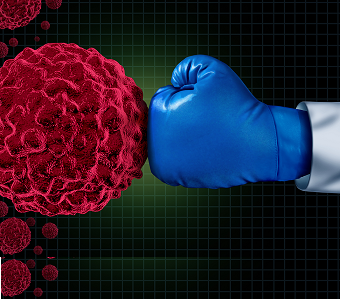First up, Ariad Pharmaceuticals’ (ARIA) Iclusig.
ARIA has regained almost 50%, or $932 million, in lost market value since U.S. regulators announced the resumption in marketing of its blood cancer treatment Iclusig. Nonetheless, many continue to see the biotech’s enterprise value of $1.2 billion as discounting the commercial prospects of the leukemia drug – and ignoring AP26113, a small-molecule targeted therapy being investigated in a pivotal Phase 2 trial of patients with non-small cell lung cancer. Here, we revisit this once-thrilling new drug, and where expectations are now.
On October 31, the FDA asked Ariad to suspend marketing and sales of Iclusig (ponatinib) after a review of clinical trial data showed at least 20% of all patients taking the tyrosine kinase inhibitor (TKI) had developed life-threatening blood clots and severe narrowing of blood vessels.
The revised marketing label approved by the FDA in December 2013 now permits use of Iclusig only in certain subsets of chronic myeloid leukemia (CML) or Philadelphia positive (Ph+ chromosome) acute lymphoblastic leukemia (ALL) patients whose cancers have progressed after treatment with – or exhibit resistance to – all other approved TKIs, which include Novartis’ (NVS) first-in-class Gleevac (imatinib), Pfizer’s (PFE) Bosulif (bosutnib), and Bristol-Myers Squibb’s (BMY) Sprycel (dasatinib). Previously, Iclusig was indicated for second-line use after one TKI-treatment failure.
Though the stock has rallied off its 52-week low of $2.15 per share (October 31, 2013) to the $7.00 level, it still trades significantly below its 52-week high of $23.00 (September 11, 2013). The relief rally has stalled for two reasons:
- Iclusig competes in an already crowded market for just two rare cancers. According to National Cancer Institute statistics, approximately 5,200 new cases of CML and 1,800 new cases of Ph+ ALL are diagnosed each year in the United States; and,
- Ariad has discontinued – after consulting with the FDA – its EPIC trial, which had been designed to investigate the use of Iclusig in the front-line settings.
A better understanding of the CML and ALL disease-states, contend ARIA bulls, suggests that even with limited patient access, Iclusig can still generate impressive annual sales given the high price of TKI drugs and the fact that patients must take them for the rest of their lives.
CML is a rare form of leukemia characterized by an excessive and unregulated production of immature white blood cells, granulocyte (“myeloid”) precursor cells, by the bone marrow due to a genetic abnormality that produces the BCR-ABL protein (which signals bone marrow to keep making abnormal white blood cells). Though the chronic phase can last months or years, CML typically evolves to the more aggressive phases referred to as accelerated phase and blast phase.
Discovery that the mutated BCR-ABL oncoprotein encodes molecular abnormalities causing CML — via disruptive receptor tyrosine kinase signaling – has paved the way for the development of targeted anticancer therapies, like TKI-treatments Gleevac and Iclusig.
Ph+ ALL is a subtype of acute lymphoblastic leukemia that carries the Ph+ chromosome producing BCR-ABL. It has a more aggressive course than CML and is often treated with a combination of chemotherapy and tyrosine kinase inhibitors. The BCR-ABL protein is overexpressed in both of these diseases.
Though considered a rare cancer, the estimated prevalence of CML in the U.S. is expected to grow from approximately 70,000 in 2010 to 112,000 by 2020, according to the NCI: the more CML and Ph+ ALL patients treated with TKIs, according to research, the higher the total number of patients who will develop resistance or intolerance over time to these therapies.
In other words, there may still be room for growth in a market for next-generation drugs – a market currently valued at more than $6 billion annually and led by Novartis (NVS) (Gleevac & Tasigna) and Bristol-Myers Squibb (BMY) (Sprycel).
Notably, as mutations arise, up to 20% – 25% of patients previously achieving a hematological or cytogenetic response with the leading TKIs may develop resistance to treatment, according to a growing body of evidence, significantly increasing their risk for disease progression, which creates a growing market opportunity for Iclusig.
Iclusig is the only licensed TKI that successfully binds to the most commonly mutated kinase, T3151. Despite the new restrictive labeling, this means is that the de novo emergence of a T3151-postive market represents a commercially attractive opportunity – the TKI class of drugs commonly retail for more than $100,000 annually per patient.
At a recent health-care conference, ARIA management estimated that there are approximately 3,100 patients in the United States, 3,800 patients in Europe and 600 patients in Japan with CML and Ph+ ALL who will become resistant or intolerant to their existing TKI therapy in 2014. Though the company won’t achieve instant market penetration, it’s still worth doing the math for more realistic thresholds:
- 1,300 new patients annually in the U.S. at an average treatment cost of $125,000 per annum equals gross revenue potential of $162.5 million;
- 2,500 eligible patients in 15 EU countries (plus Japan) at an average treatment cost of $100,000 per annum equals gross revenue potential of $250 million.
Given this run-rate of $375 million and a current market cap of $1.3 billion, or about 3.4 times potential sales, the stock seems fairly valued. However, this ignores the fact that Iclusig, a multi-targeted TKI, might prove valuable in a number of other cancers, including certain lung cancers and in patients with metastatic and/or resectable GI stromal tumors, called GIST.
Given 4,500 newly diagnosed GIST patients in the U.S. each year, and 50% treatment failure rate with Gleevac due to drug resistance, the commercial potential for this indication alone could be around $300 million (assuming 20% market share within 5 years).
Finally, ARIA bulls contend that Wall Street ignores the commercial potential of AP26113, an oral inhibitor of anaplastic lymphoma kinase (ALK). To date, the ALK oncogene has been implicated in up to 60% of certain non-Hodgkin lymphomas and a small sub-set of non-small cell lung cancer (NSCLS) patients.
Last month ARIA announced the start of a pivotal Phase 2 trial of AP26113 in patients with NSCLC who were previously treated with Pfizer’s Xalkori (crizotinib). The primary endpoint is objective response rate (percent decrease in the aggregate size of target lesions); secondary endpoints include time to response, duration of response, disease control rate, progression free survival, overall survival, and safety (pulmonary toxicity of AP26113 was observed in a previous study at higher doses). ARIA expects completion of enrollment in 3Q15 and plans to present first data at a medical meeting in 2015. Although Xalkori is effective, up to 50% of patients still progress within a year; often Xalkori-treated resistance progresses to brain metastases.
Approximately 14,200 ALK-positive patients with advanced and metastatic NSCLC in the United States, Europe and Japan would be potential candidates for treatment with AP26113 according to ARIA’s 2013 annual SEC filing. Assuming AP26113 were to be priced competitively with Xalkori ($115,200 per annum, on average), the potential market size just for eligible NSCLC patients would range in the billions.
But of importance, Novartis’ ceritinib, a competing ALK inhibitor, could be approved within the month. This and progress from Roche (RHHBY) on the ALK inhibitor alectinib have taken the “novelty” off of the ‘113 story for many.
Management expects that its existing cash position ($237 million) will be sufficient to fund operations to mid-2015. Given a net burn of $233 million last year this is unlikely. We expect the company to again look to the capital markets to raise the substantial funding that will be required for existing research and development programs (including pre-clinical development and clinical trials), barring any surprise licensing deals.
As for the stock price, the first catalyst for a sustained move above the $8.00/share level (50-day moving average) would be news that the FDA is lifting the partial clinical hold currently in place for GIST and other trials.
One or more of PropThink’s contributors are long BMY.




